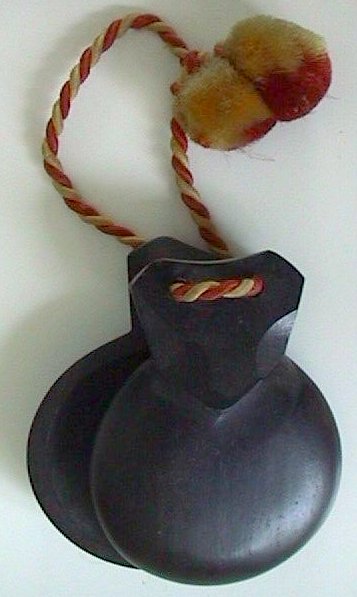- Castanet
Infobox instrument
name=Castanet(s)
names=
image_capt=
color=#FFEC8B
classification=Percussion instrument (Idiophone )
range=
related=
musicians=
builders=
articles=Castanets are
percussion instrument (idiophone ), much used inMoorish , Ottoman, Ancient Roman, Italian, Spanish, Portuguese andLatin American music . The instrument consists of a pair of concave shells joined on one edge by string. These are held in the hand and used to produce clicks for rhythmic accents or a ripping or rattling sound consisting of a rapid series of clicks. They are traditionally made of hardwood, although fibreglass is becoming increasingly popular.In practice a player usually uses two pairs of castanets. One pair is held in each hand, with the string hooked over the thumb and the castanets resting on the palm with the fingers bent over to support the other side. Each pair will make a sound of a slightly different pitch. The higher pair, known as "hembra" (female), is usually held in the right hand, with the larger "macho" (male) pair held in the left.
Castanets are often played by singers or dancers, and are prominently used in
flamenco music. The name (Spanish: "castañuelas") is derived from the diminutive form of "castaña", the Spanish word forchestnut , which they resemble. InAndalusia they are usually referred to as "palillos" (little sticks) instead, and this is the name by which they are known in flamenco.The origins of the instrument are not known. The practice of clicking hand-held sticks together to accompany dancing is ancient, and was practiced by both the Greeks and the Egyptians. In more modern times, the bones and
spoon s used inMinstrel show andjug band music can also be considered forms of the castanet.When used in an orchestral setting, castanets are sometimes attached to a handle, or mounted to a base to form a pair of "machine castanets". This makes them easier to play, but also alters the sound, particularly for the machine castanets. It is possible to produce a roll on a pair of castanets in any of the three ways in which they are held. When held in the hand, they are bounced against the fingers and palm of the hand; on sticks, bouncing between fingers and the player's thigh is one accepted method. For a machine castanet, a less satisfactory roll is obtained by rapid alternation of the two castanets with the fingers.
During the baroque period, castanets are featured prominently in dances. Composers like
Jean-Baptiste Lully scored them for the music of dances which included Spaniards (Ballet des Nations), Egyptians (Persée, Phaëton), Ethiopians (Persée, Phaëton), andKorybantes (Atys). In addition, they are often scored for dances involving less pleasant characters such asdemon s (Alceste ) andnightmare s (Atys). Their association withAfrican dance s is even stated in the ballet Flore (1669) by Lully, “...les Africains inventeurs des danses de Castagnettes entrent d’un air plus gai...”Castanets were used to evoke a Spanish atmosphere in
Georges Bizet 'sopera , "Carmen " andEmmanuel Chabrier 's orchestral work "España". They are also found in the "Dance of the Seven Veils" fromRichard Strauss ' opera "Salome" and inRichard Wagner 's "Tannhäuser ". An unusual variation on the standard castanets can be found inDarius Milhaud 's "Les Choëphores", which calls for castanets made ofmetal . Other uses includeRimsky-Korsakov 's "Capriccio espagnol ",Ravel 's "Rapsodie espagnole " andKarl Jenkins 's "Tangollen".A rare occasion where the normally accompanying instrument is given concertant solo status is
Leonardo Balada 's Concertino for Castanets and Orchestra Three Anecdotes (1977). The "Conciertino für Kastagnetten und Orchester" by the German composer Helmut M. Timpelan, in cooperation with the castanet virtuoso, José de Udaeta, is another solo work for the instrument.In the late Ottoman empire,
köçek s not only danced but played percussion instruments, especially a type of castagnette known as the "çarpare", which in later times were replaced by metal cymbals called "zill s".See also
*
Krakebs
Wikimedia Foundation. 2010.
